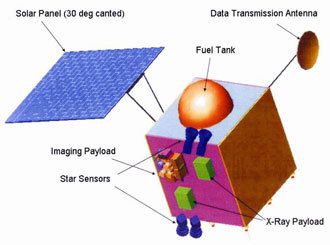-
 Dew point
Dew point
-
 Meteorite swarm
Meteorite swarm
-
 Prehensile
Prehensile
-
 Oceanic crust
Oceanic crust
-
 Arthritis
Arthritis
-
 Quantum entanglement
Quantum entanglement
-
 Voice recognition
Voice recognition
-
 Fibrate
Fibrate
-
 Volcanism
Volcanism
-
 Hypocentre
Hypocentre
-
 Hydrolase
Hydrolase
-
 Antidiabetic
Antidiabetic
-
 TDG risk
TDG risk
-
 Ecological continuum
Ecological continuum
-
 Stirling formula
Stirling formula
-
 Optical disk
Optical disk
-
 Natural CO2 sequestering
Natural CO2 sequestering
-
 Pay per view
Pay per view
-
 Amylose
Amylose
-
 Antispasmodic
Antispasmodic
-
 UAC
UAC
-
 M65
M65
-
 DTT
DTT
-
 Tubercle
Tubercle
-
 Switched virtual circuit
Switched virtual circuit
-
 Conglomerate
Conglomerate
-
 Auxin
Auxin
-
 Dynamic super-resolution microscope
Dynamic super-resolution microscope
-
 Wood pellets
Wood pellets
-
 Belemnites
Belemnites
Chandrayaan-1
Chandrayaan-1 is an Indian automatic lunar probe (ISRO, Indian Space Research Organization) launched from the Sriharikota base on 22 October 2008, on a PSLV rocket equipped with Psom-XL thrusters. It was initially placed in a 500 x 5000 km elliptical orbit around the Moon on 4 November 2008; this was gradually brought to a 100 x 100 km circular polar orbit on 8 November 2008.
Its mission was to completely map the surface of the Moon, analyse the mineralogical composition of the soil, study the Moon's crust to better understand its evolution and to look for water in the polar regions. The data from Chandrayaan-1 was also used to make 3D maps of some regions of the Moon, and will be used to analyse magnetic anomalies detected by other missions.
Instruments on board:
- HySI spectral imager (India)
- TMC mapping camera (India)
- LLRI laser altimeter (India)
- CIXS low energy X-ray spectrometer (ESA/RAL British laboratory)
- HEX High energy X-ray spectrometer (India)
- SIR-2 infrared spectrometer (ESA/Max Planck Institute)
- M3 infrared spectrometer (United States)
- Cena neutral atom detector
- Sub KeV Atom Reflecting Analyser (SARA), an apparatus for studying the interaction between the solar wind and the lunar surface (ESA/Swedish Institute for Space Physics/Indian Institute for Space Physics)
- MiniSAR S-band radar to search for water ice at the poles (United States)
- SXM environmental energetic particle monitor (Bulgaria)
The probe mission was planned to last two years but it ended after 312 days owing to a technical failure, after completing 95% of its objectives.
Chandrayaan-1 also carried an impactor designed to strike lunar soil near the south pole, which sent images and data on the very weak atmosphere during its descent.
 Artist's impression of Chandrayaan-1.
(Credits: Indian Space Research Organization)
Artist's impression of Chandrayaan-1.
(Credits: Indian Space Research Organization)
Latest
Fill out my online form.



